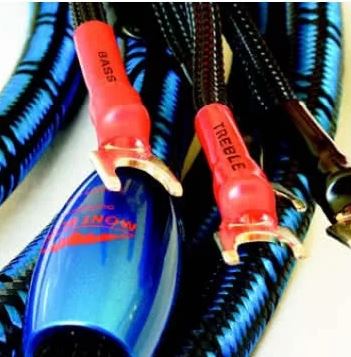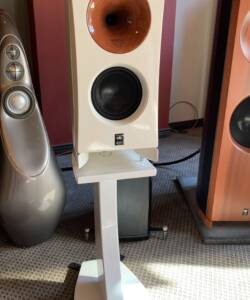AudioQuest Mont Blanc Speaker Cables
Original price was: R90,000.00.R14,900.00Current price is: R14,900.00.
Conclusions
The new AudioQuests are very good-sounding cables. The Cheetahs, in particular, performed beautifully well in my system: They’re among the two or three best interconnects I’ve ever experienced. But I find their cost prohibitive, especially since cables that perform almost as well—and silver cables, at that—can be made for less than the AudioQuests’ price.
I’m inclined to believe that the Cheetah interconnects and Mont Blanc speaker cables sound good because they’re reasonably simple—simpler, even, than other, earlier AudioQuest designs. I think it’s also because their connectors are sensibly low in mass, because they’re well made, and because they use conductive metals that are evidently very high in quality. My belief is that their “dielectric bias” system, which I wound up removing and leaving in my desk drawer, has no influence on their performance one way or the other. I remain open to suggestions that I’m wrong (footnote 2), but only if those suggestions are offered with such features as CUD (calm, unheated discourse) and ELFC (extremely low fertilizer content).
And years from now, when I’m busy reviewing hearing-aid batteries for the large-print edition of Stereophile, I will look fondly back on this portion of my professional life: when I got paid for listening to wires. Maybe this job isn’t so bad after all.
Description
PERFECT-SURFACE COPPER+: Mont Blanc uses extremely high purity Perfect-Surface Copper+ (PSC+) conductors. All conductors are solid, which prevents strand interaction, a major source of distortion. Surface quality is critical because a conductor can be considered as a rail-guide for both the electric fields within a conductor, and for the magnetic fields outside the conductor. The astonishingly smooth and pure Perfect-Surface eliminates harshness and greatly increases clarity compared to OFHC, OCC, 8N and other coppers. The superior purity of PSC+ further minimizes distortion caused by grain boundaries, which exist within any metal conductor.
DIELECTRIC-BIAS SYSTEM (patent pending): Unfortunately, because insulation stores and releases energy, it is also a “dielectric.” In a cable application, all released energy is distortion. The misnomer “break-in” is often used to describe the pronounced improvement in performance as the dielectric adapts to a charged state as the cable is used. Whenever a cable does not have a charge on it, it is re-adapting to an uncharged state; it is becoming new again.
By maintaining a 36 volt dielectric-bias, far above the voltage of delicate audio signals, the DBS system provides considerably better transparency and dynamics than is possible even from a cable in continuous use. It takes a couple of weeks for the DBS system to reach maximum performance. Since DBS battery packs are attached when Mont Blanc cables are first terminated, Mont Blanc will be approaching or at peak performance by the time it is installed in your system. Since there is no “load” on the two standard hardware-store batteries, they will last for years. A test button and LED allow for occasional verification of battery performance.
COUNTER SPIRALING “EARTH FEATURE” GEOMETRY: Mont Blanc and the other AQ “Earth Feature” cables have an inner circular array of positive conductors spiraling in one direction. Around this inner group, are the negative conductors, spiraling in the opposite direction. Even while the positive and negative conductors are crossing each other instead of being parallel, the relationship between the positive and negative groups is fixed and non-changing, adhering to one of AudioQuest’s most basic design tenets: consistency. The result is an astonishing clarity, like focusing a camera lens you had no idea was so far out of focus.
SST (Spread Spectrum Technology): Any single size or shape of conductor has a specific distortion profile. Even though radially symmetrical conductors (solid round or tubular) have the fewest discontinuities, any particular size does have a sonic signature. SST uses a precise combination of different size conductors in order to significantly reduce the audibility of these character flaws. The four different SST-determined conductor sizes used in Mont Blanc allow an exceptionally clear, clean and dynamic sound.
CONDUCTIVE INSULATION: The five negative conductors in Mont Blanc are insulated with partially conductive carbon-loaded polyethylene. This remarkable material damps radio-frequency garbage from being fed back into the amplifier. The sonic benefit is exactly the same reduction in “hash” and better dimensionality that comes whenever RF garbage is reduced in an audio circuit.
TERMINATIONS: AudioQuest offers a wide range of high quality connectors that allow Mont Blanc to be securely attached to any type of equipment. AQ ends are dull looking because the silver (or gold) is plated directly over the connector. There is no harsh sounding shiny nickel layer underneath. AQ spade lugs are plain looking and soft because pure copper is soft. Also, compressibility facilitates a higher quality connection. AQ spade lugs are available in several sizes. AQ PSC Benda-Pins fit all equipment, except components accepting only a banana plug or BFA connector, in which case the AQ Crimp BFA/Banana provides unprecedented performance at a fraction the cost of those not-so-good sounding big “eye-candy” versions.
BIWIRING: When possible, running separate conductors or separate cables to the treble and bass halves of a speaker will considerably reduce distortion. BiWiring works because cable causes distortion, which can be minimized by keeping the bass energy out of the treble cable. Mont Blanc is an ideal full-range cable. It can also be used as a double pair for maximum benefit from BiWiring. Mont Blanc has also been designed to make it possible to Single-BiWire. The five conductors per polarity have been chosen and arranged so that they may be divided into two groups, allowing Mont Blanc to be prepared with four connections on the speaker end.








